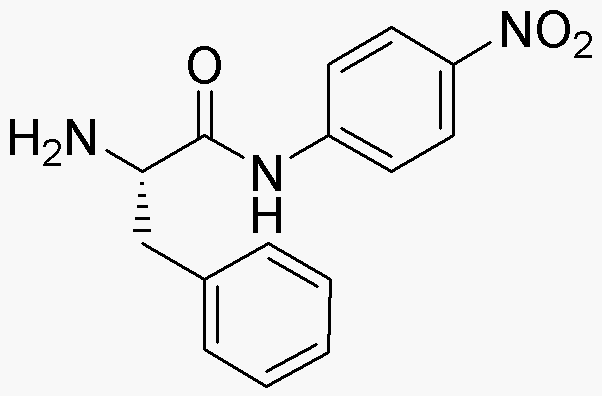L-Phenylalanine 4-nitroanilide is widely utilized in research focused on:
- Biochemical Assays: This compound serves as a substrate in enzyme assays, particularly for proteases, allowing researchers to measure enzyme activity effectively.
- Drug Development: It is used in the pharmaceutical industry to develop new drugs targeting specific biochemical pathways, enhancing the understanding of drug interactions.
- Protein Studies: The compound aids in the study of protein folding and stability, providing insights into protein behavior under various conditions.
- Analytical Chemistry: It is employed in chromatographic techniques for the separation and identification of amino acids and peptides, streamlining analytical processes.
- Educational Purposes: This chemical is often used in academic laboratories to teach students about amino acid properties and reactions, fostering hands-on learning experiences.
General Information
Properties
Safety and Regulations
Applications
L-Phenylalanine 4-nitroanilide is widely utilized in research focused on:
- Biochemical Assays: This compound serves as a substrate in enzyme assays, particularly for proteases, allowing researchers to measure enzyme activity effectively.
- Drug Development: It is used in the pharmaceutical industry to develop new drugs targeting specific biochemical pathways, enhancing the understanding of drug interactions.
- Protein Studies: The compound aids in the study of protein folding and stability, providing insights into protein behavior under various conditions.
- Analytical Chemistry: It is employed in chromatographic techniques for the separation and identification of amino acids and peptides, streamlining analytical processes.
- Educational Purposes: This chemical is often used in academic laboratories to teach students about amino acid properties and reactions, fostering hands-on learning experiences.
Documents
Safety Data Sheets (SDS)
The SDS provides comprehensive safety information on handling, storage, and disposal of the product.
Product Specification (PS)
The PS provides a comprehensive breakdown of the product’s properties, including chemical composition, physical state, purity, and storage requirements. It also details acceptable quality ranges and the product's intended applications.
Certificates of Analysis (COA)
Search for Certificates of Analysis (COA) by entering the products Lot Number. Lot and Batch Numbers can be found on a product’s label following the words ‘Lot’ or ‘Batch’.
*Catalog Number
*Lot Number
Certificates Of Origin (COO)
This COO confirms the country where the product was manufactured, and also details the materials and components used in it and whether it is derived from natural, synthetic, or other specific sources. This certificate may be required for customs, trade, and regulatory compliance.
*Catalog Number
*Lot Number
Safety Data Sheets (SDS)
The SDS provides comprehensive safety information on handling, storage, and disposal of the product.
DownloadProduct Specification (PS)
The PS provides a comprehensive breakdown of the product’s properties, including chemical composition, physical state, purity, and storage requirements. It also details acceptable quality ranges and the product's intended applications.
DownloadCertificates of Analysis (COA)
Search for Certificates of Analysis (COA) by entering the products Lot Number. Lot and Batch Numbers can be found on a product’s label following the words ‘Lot’ or ‘Batch’.
*Catalog Number
*Lot Number
Certificates Of Origin (COO)
This COO confirms the country where the product was manufactured, and also details the materials and components used in it and whether it is derived from natural, synthetic, or other specific sources. This certificate may be required for customs, trade, and regulatory compliance.


